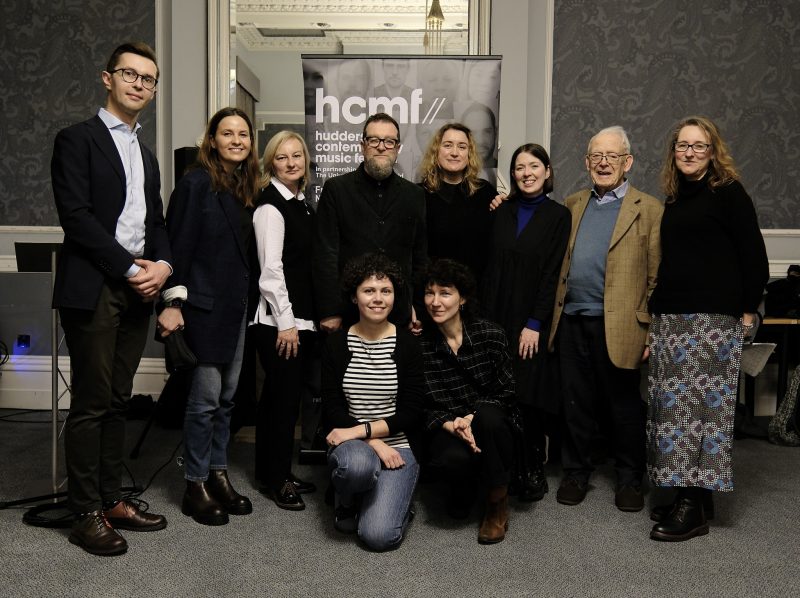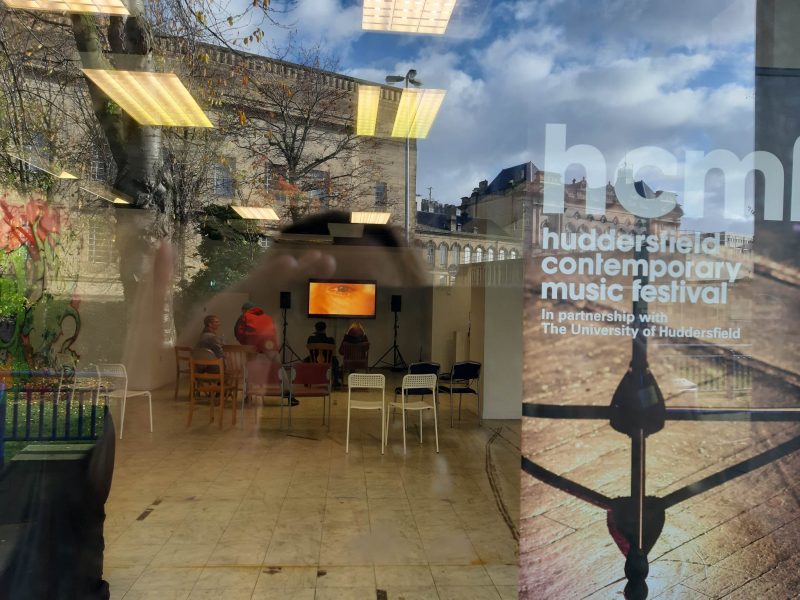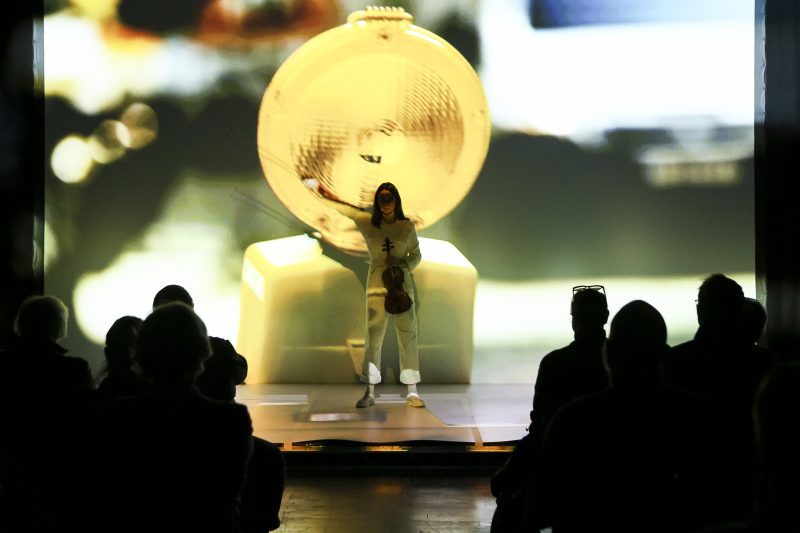The opening chord of the three-year focus on Lithuania at the international Huddersfield Contemporary Music Festival: premieres, returns and an audience that holds its breath


The 45th international contemporary music festival, called hcmf//, which took place on 18-27 November in the city of Huddersfield, United Kingdom, marked the start of the festival’s three-year collaboration with Lithuania, which will be created jointly by the Lithuanian Culture Institute, the Lithuanian Music Information Centre (LMIC) and the Lithuanian cultural attaché in the UK, Ūla Tornau.
“It is a country we have been wanting to work with! Lithuania has a pronounced musical streak, and a lot of discoveries await us”, said Graham McKenzie, who has been managing the festival for 16 years, at the informal partnership inauguration ceremony, noting that the partnership was fostered by the unwavering professionalism of the Lithuanian partners and the notable Lithuanian performances in the festival in the past. “I remember Justė Janulytė’s fantastic project Sandglasses presented to us 12 years ago, which, by the way, adorns the book of the festival founder Richard Steinitz about the history of hcmf//. I still get to hear comments and impressions about that wonderful piece”, said the artistic director, sharing his joy at Janulytė’s return to Huddersfield this year with two UK premieres.
McKenzie also mentioned Lina Lapelytė, who participated in the festival in 2010 as part of The New String Theory and is currently conquering the world stages with the Venice Biennale award-winning Sun and Sea. The artistic director looks forward to working with Lapelytė during the festival’s partnership with Lithuania. “Currently, Lithuanian music creators are actively involved in international networks, are forging partnerships and are being seen and heard; they are now past the point of coming from obscurity and are becoming established on the global cultural map. Nonetheless, the three-year status of the focus country of the festival, which sets the trends of contemporary music, will help focus audiences’ attention on the uniqueness of our music creators and performers,” said the director of the Lithuanian Culture Institute, Aušrinė Žilinskienė.
English conversations about the weather
The festival was founded in 1978, during one of the waves of cultural decentralisation and increased funding for parts other than London in the United Kingdom. The University of Huddersfield was already famous for its 20th-century music school, and the university professor and composer Richard Steinitz became the director of the festival, a position he held until 2001. It is not by chance that the festival takes place in November: this is when students have a period of independent study, so the university premises can be used for festival events. “Steinitz should have chosen a warmer month to release his students: as it is, we are doomed to be cold and soaked forever”, complained the current artistic director McKenzie with inimitable Scottish humour (helped by many years of experience as a stand-up comedian).
Talking and writing about what a peculiar destination for the annual contemporary music pilgrimage is a small post-industrial West Yorkshire town in November is one of the festival’s traditions. For over four decades, the hosts of the festival have been tirelessly apologising for the constant rain and fog, while the loyal audience demonstrates not only a great knowledge of modern music but also resilience to challenging weather conditions.
McKenzie recounts that once the weather was so cold and wet that drenched audience members were literally steaming during the concerts as if theirpockets were stuffed with dry ice… “I think that was the ultimate unifying experience and the essence of our festival,” joked the artistic director in the most serious voice.
McKenzie has been programming this festival since 2006, bringing with him the experience of working at the Glasgow Centre for Contemporary Arts: now hcmf// has more visual arts, experimental, improvisational and interdisciplinary pieces, electronic music and performance. He also discovered more concert venues in non-traditional spaces of the town: near the university auditoriums, St. Paul’s Church, which belongs to the university’s architectural ensemble, the town hall, and the Bates Mill spinning factory, still operating as a third-generation textile company. The brothers Nigel and Richard Bates, who run the mill (and according to McKenzie, persuaded by him), have become akin to symbols of the festival, attending all the concerts held at the Bates Mill (and pouring drinks behind the bar).

A place where unique artists meet unique audiences
Justė Janulytė’s piece Unanime, which opened the festival’s three-year focus on Lithuania, was performed by the German trumpet ensemble The Monochrome Project at St. Paul’s Church, while her latest opus Sleeping Patterns with the London Sinfonietta was performed in Huddersfield Town Hall featuring original Victorian interior. Both works by the Lithuanian composer were received very warmly by the audience, who listened with great attention to the nuances of the monochrome music. Another hcmf// tradition is to collect the autographs of composers and performers on the festival app: thus the creators of contemporary classical music have the opportunity not only to see the audiences’ reactions but also enjoy their attention and admiration (“But they can also be booed or criticised”, added by the festival organisers).
“I think that hcmf// was very important for my entire creative biography”, reflected Justė Janulytė. “I came here for the first time in 2008, when the festival, on the initiative of musician Anton Lukoszevieze, commissioned me to write a piece for cello with a recorded instrument, electronics. That piece continues to be played in various versions, with different instruments: violins, guitars, accordions, and string quartets. Then the artistic director of the festival, Graham McKenzie, noticed me, and that’s how our collaboration started, and the history of Sandglasses began”, recalled Janulytė her experience at Huddersfield.
“I’m delighted to be back here after twelve years. No audience listens like here – you simply feel that it is holding its breath, and once the piece is finished, there is always a long pause before the applause. After the concert, many people approach you for a chat. The festival’s links with the University of Huddersfield are also important, and it has a very highly-rated and important school of musical composition, where many aspire to study. I once considered it myself, as I felt attracted by its outstanding environment”, the composer shared her experiences of the festival’s atmosphere and the genuine attention of its audiences.

The second Lithuanian ‘chord’ in this year’s programme was an improvised sound sculpture by Vilnius’ Sneeze Etiquette (Arturas Bumšteinas, Kristupas Gikas, Adas Gecevičius and Dominykas Snarskis). They were scheduled to perform on the most challenging day of the festival, in the so-called Shorts programme, which took place across all the festival stages from noon to midnight in the pouring rain. Sneeze Etiquette’s performance at the Bates Mill photography studio was the penultimate show, followed by Jan Hendrickse’s performance Black Noise, which was watched in the factory yard by the hardiest audience: the musician “played” a bamboo flute with an acetylene torch, eventually burning it.
The technical team of the experimental sound session held by the Vilnius musicians in the photography studio, having apparently assessed the potential of the two drum kits in the chamber space, distributed earplugs to the audience. However, there was no need for them, as during the performance Adas Gecevičius and Dominykas Snarskis caressed the drums rather than banged them.
The musicians shared that they were a little worried that they might get a small and lifeless audience, but that was not the case at all: the studio was filled to the brim with attentive and receptive listeners. “It was a great pleasure to play here,” shared composer Arturas Bumšteinas, one of the “elements” of the sound sculpture, after the concert. It is hardly possible to keep secret that in next year’s Lithuanian focus programme, there will be more of Bumšteinas’ work: research and exploratory work have already begun. It should also be mentioned that in 2009, Bumšteinas’ work Diagonal Symphony (with A. Lukoszevieze) was performed at the festival.
The Bates Mill concert space also hosted the music and media project This Order Goes Wrong, which talks about the increasingly frequent companion of modern life: panic attacks. The authors of the project are composer Dominykas Digimas, playwright Rimantas Ribačiauskas, video director Kristijonas Dirsė, and costume designer Morta Nakaitė, alongside voice, sensory and movement specialists. The project was performed by violinist and actress Lora Kmieliauskaitė.

The first year of the festival’s focus on Lithuania culminated with the presentation of the debut album by the ensemble Twenty Fingers Duo (Lora Kmieliauskaitė and Arnas Kmieliauskas), Performa. Performa is a visually intoned sound journey, for which the duo had commissioned compositions from composers Mykolas Natalevičius, Dominykas Digimas, Rūta Vitkauskaitė, Julius Aglinskas, Arturas Bumšteinas and Andrius Maslekovas. Artist Lauryna Narkevičiūtė created six visuals for the project, which were projected in a live performance by Kristijonas Dirsė.
According to Kmieliauskaitė, who links the final two parts of the Lithuanian programme, she and her colleagues still find it hard to fully comprehend and assess what taking part in this festival means to them: “Perhaps later we will see what new work and friendships will grow from it. First and foremost, we are just happy to have been invited to present our creative outlet here, at one of the biggest festivals of contemporary and experimental music. We felt a really big responsibility to represent the music field of our country and present new music ideas from Lithuania. The festival as a platform attracts not only audiences but also artistic directors of other festivals, other artists and ensembles. It is really interesting to get a feel for what is playing now and what kind of musical waves are rolling in the world at the moment. We first presented the performance This Order Goes Wrong, and it seems that the positive atmosphere from that evening followed our creative group until the end of the festival. We are delighted that, thanks to the acquaintances made at the festival, our pieces will travel on”, shared Lora Kmieliauskaitė.
“It might be unusual to hear this from performers, but we were elated after the concert. We were particularly impressed by the absolute silence between the pieces: the audience’s attention did not waver, and we felt their engagement until the final chord. It is an amazing feeling for a performer. It is simply wonderful to play at a festival with such an energetic audience, hungry for the sound of new music: during the performance we don’t have to think about pleasing the listeners at all or do much explaining but instead can concentrate on the actual performance of the compositions, and enjoy it with the certainty that we will be heard”, the musician shared her appreciation of the hcmf// audience.